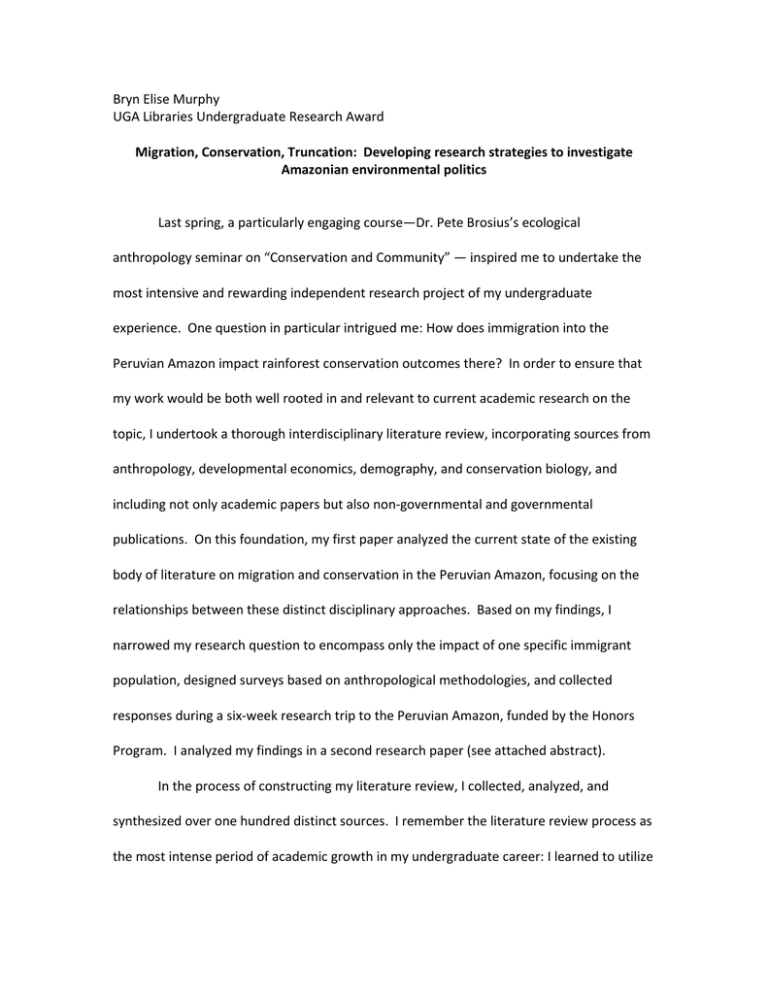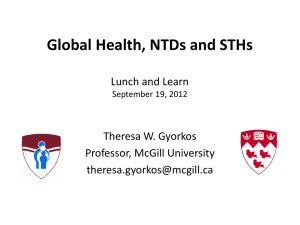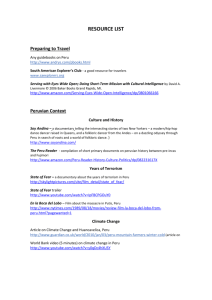Bryn Elise Murphy UGA Libraries Undergraduate Research Award
advertisement

Bryn Elise Murphy UGA Libraries Undergraduate Research Award Migration, Conservation, Truncation: Developing research strategies to investigate Amazonian environmental politics Last spring, a particularly engaging course—Dr. Pete Brosius’s ecological anthropology seminar on “Conservation and Community” — inspired me to undertake the most intensive and rewarding independent research project of my undergraduate experience. One question in particular intrigued me: How does immigration into the Peruvian Amazon impact rainforest conservation outcomes there? In order to ensure that my work would be both well rooted in and relevant to current academic research on the topic, I undertook a thorough interdisciplinary literature review, incorporating sources from anthropology, developmental economics, demography, and conservation biology, and including not only academic papers but also non-governmental and governmental publications. On this foundation, my first paper analyzed the current state of the existing body of literature on migration and conservation in the Peruvian Amazon, focusing on the relationships between these distinct disciplinary approaches. Based on my findings, I narrowed my research question to encompass only the impact of one specific immigrant population, designed surveys based on anthropological methodologies, and collected responses during a six-week research trip to the Peruvian Amazon, funded by the Honors Program. I analyzed my findings in a second research paper (see attached abstract). In the process of constructing my literature review, I collected, analyzed, and synthesized over one hundred distinct sources. I remember the literature review process as the most intense period of academic growth in my undergraduate career: I learned to utilize academic search tools effectively, to deal with vast amounts of information efficiently, and to integrate academic sources with primary sources such as interviews and gray literature. I began my search for relevant literature using basic search tools such as GIL and Google Scholar, but through an information session with librarian Elizabeth White, I learned to use the “Advanced Search” functions of EBSCO Host, Academic Search Complete, JSTOR, and the relevant subject databases available through GALILEO. The strategies I learned through that information session proved invaluable: I learned how to filter out sources that were either not peer-reviewed or unavailable in full-text form and how to use the truncation functions built into each search tool to my advantage. In a later consultation, librarian Caroline Barratt introduced me to another search tool, Web of Science, which I have since used to further develop my papers in preparation for presentation at the 2011 CURO Symposium. Beyond these information sessions and consultations with UGA librarians, my development as a researcher also continued through alternative paths. For example, I adapted the strategies for truncation that I had learned from Librarian White in order to retrieve sources in both Spanish and English simultaneously by choosing search terms with similar roots in each language and truncating them where the two languages diverged—for example, “migra*” to retrieve results related to both “migration” and “migración”. I also learned to adapt my search terms according to my results, broadening or narrowing them as necessary, or incorporating phrases that did not necessarily appear in my research question but that seemed to appear frequently in relevant papers, such as “rural-rural migration” and “Andean-Amazon migration”. It was also through this research project that I learned to use UGA Libraries’ Interlibrary Loan and Reserves request services to retrieve harder-to-find print sources. Further, a graduate student in my field taught me how to download and use EndNote citation management software from the UGA Libraries webpage to better store and organize my source materials. The “Groups” function of EndNote proved particularly helpful to the literature review process: by sorting each new source according to its discipline (anthropology, developmental economics, demography, or conservation biology) and its source (academic, non-governmental organization publication, or governmental publication), I developed a clearer picture of the body of literature as a whole, which disciplines and sources were well-represented, and which were underrepresented. Perhaps the most valuable skill I learned through the literature collection process was where to turn when it seemed that the flow of new sources had run dry— references and citations. Whenever I identified a particularly useful paper, I scanned its footnotes for relevant titles, then followed these leads to new sources. Whenever a particular author reappeared several times in my searches, I located their faculty webpage and scanned their curriculum vitae for further leads in new formats, such as books, lectures, or interviews. Similarly, whenever a non-governmental or governmental organization was mentioned in a source, I searched that organization’s publication archives for relevant documents. In this way, I learned to squeeze every last drop of utility out of each source, allowing me a new confidence in the comprehensiveness of my literature review. Beyond the literature collection process, the analysis and synthesis of these source materials pushed me to engage more deeply with my source materials and to become a more intelligent library researcher. Given the highly interdisciplinary nature of my research topic, it was tempting to attempt to include every tangentially related source in my literature review. However, I gradually learned to balance comprehensiveness with relevance, and to distinguish useful sources from distracting ones. Further, I learned to more intelligently evaluate each source’s objectivity and usefulness according to its discipline or origin. For example, what assumptions does research in developmental economics make that research in anthropology does not? What bureaucratic biases might influence a non-governmental or governmental publication that might not influence an academic publication? My literature review process exposed both a lack of cross-disciplinary dialogue and a lack of up-to-date research on the relationship between conservation and migration in the Peruvian Amazon. My second paper represented an attempt to fill these gaps in the literature through the collection and analysis of new primary sources through interviews with migrants to the Peruvian Amazon. Throughout my research project— from the collection of relevant literature, to the analysis of the composition and shortcomings of that body of literature, to an attempt to resolve those shortcomings through my own independent study— I have developed a more intimate understanding of the challenges of the research process, as well as a fuller set of research tools and strategies with which to meet those challenges. “Cuando uno toma el agua del Tambopata…”: Migration and the urban environment in Madre de Diós, Peru The region of Madre de Diós, Peru, contains the best-preserved area of the Amazon rain forest and the highest levels of biodiversity on earth. Because of this notoriety, Madre de Diós is also home to a high concentration of non-governmental organizations (NGOs) focused on conservation and sustainable development. These NGOs are predominantly staffed by non-local professionals who were raised and educated in urban areas of Peru and later migrated to Madre de Diós to work. The purpose of this study was to evaluate whether the non-local and originally-urban characteristics of these NGOs’ workforces affect conservation outcomes in rural versus urban areas of Madre de Diós. Interviews were conducted on a sample of fifteen employees of NGOs in Madre de Diós. Interviewees’ responses were analyzed with reference to the social constructivist school of thought in environmental anthropology, which argues that social constructs cause people to value rural landscapes over urban landscapes, resulting in greater investment of conservation resources into rural landscapes at the expense of urban landscapes. In contrast with the predictions of the social constructivist literature, interviewees’ responses demonstrated approximately equal valuation of rural and urban landscapes. These results suggest the need for further research, including a larger sample of interviews, to determine whether Madre de Diós truly represents a counterexample to social constructivist predictions. Reference List (Paper One) Agrawal, Arun, and C. C. Gibson 1999 Enchantment and disenchantment: The role of community in natural resource management. World Development 27(4):629-649. Alvarez, Nora L., and Lisa Naughton-Treves 2003 Linking national agrarian policy to deforestation in the Peruvian Amazon: A case study of Tambopata, 1986-1997. Ambio 32(4):269-274. Aramburu, Carlos Eduardo 1979 "Migración, campesinado y colonización en Puno (informe preliminar)". In Centro de Investigaciones Socioeconómicas (CISE)/Taller de Coyuntura Agraria/Universidad Nacional Agraria de La Molina. Lima. Aramburú, Carlos Eduardo 1981 La Expansión de la Frontera Agraría y Demográfica de la Selva Peruana. In Conference on Frontier Expansion in Amazonia. Center for Latin American Studies, University of Florida, Gainesville. Arumburu, Carlos Eduardo 1982 "Expansión de la frontera agraria y demográfica de la selva alta peruana". In Colonización en la Amazonía. C. Aramburu, Bedoya, and Recharte, eds. Pp. 1-39. Lima: CIPA. — 1983 "Las migraciones en la sociedad campesina. El caso de Puno". In El sur peruano: Realidad poblacional. Pp. 241-247. Lima: Ediciones AMIDEP. Barbieri, Alisson Flavio, David L. Carr, and Richard E. Bilsborrow 2009 Migration within the frontier: The second generation colonization in the Ecuadorian Amazon. Population Research and Policy Review 28(3):291-320. Barraclough, Solon L. 1999 Land reform in developing countries: The role of the state and other actors: UNRISD. Brosius, J. Peter, Anna Lowenhaupt Tsing, and Charles Zerner 1998 Representing communities: Histories and politics of community-based natural resource management. Society & Natural Resources 11(2):157-168. Browder, John O. 1994 Surviving in Rondonia: The dynamics of colonist farming strategies in Brazil's Northwest frontier. Studies in Comparative International Development 29(3):45. Bush, Mark B. 1996 Amazonian conservation in a changing world. Biological Conservation 76(3):219- 228. Carr, David, Laurel Suter, and Alisson Barbieri 2005 Population dynamics and tropical deforestation: State of the debate and conceptual challenges. Population & Environment 27(1):89-113. Carr, David L. 2003 Migración rural-rural y deforestación en Guatemala: Método de entrevistas. Tiempos de America: Revista de Historia, Cultura y Territorio 10(Not available):19-27. — 2008 Migration to the Maya biosphere reserve, Guatemala: Why place matters. Human Organization 67(1):37-48. — 2008 Farm households and land use in a core conservation zone of the Maya Biosphere Reserve, Guatemala. Human Ecology 36(2):231-248. — 2009 Population and deforestation: Why rural migration matters. Progress in Human Geography 33(3):355-378. Chatty, Dawn 2003 Mobile Peoples and Conservation: An Introduction. Nomadic Peoples 7(1):5-16. Chicchón, Avecita, et al. 1997 La lenta colonizacion del Inambari y el Tambopata: Uso del espacio en la selva sur del Peru. El problema agrario en debate. SEPIA VI, Lima, Peru VI(not applicable):551–587. Collins, Jane 1984 The maintenance of peasant coffee production in a Peruvian valley. American Ethnologist 11(3):413-438. Collins, Jane L. 1983 Seasonal migration as a cultural response to energy scarcity at high altitude. Current Anthropology 24(1):103-104. — 1986 The household and relations of production in southern Peru. Comparative Studies in Society and History 28(4):651-671. Coomes, Oliver T. 1996 Income formation among Amazonian peasant households in northeastern Peru: Empirical observations and implications for market oriented conservation. Yearbook International Tribunal for the Law of the Sea 22:51-64. — 1996 State credit programs and the peasantry under populist regimes: Lessons from the APRA experience in the Peruvian Amazon. World Development 24(8):1333-1346. Dana Declaration on Mobile Peoples and Conservation. 2003. Nomadic Peoples 7(1):159-162. de Sherbinin, Alix, et al. 2008 Rural household demographics, livelihoods and the environment. Global Environmental Change 18(1):38-53. Dornbusch, Rudiger, and Sebastian Edwards 1990 Macroeconomic populism. Journal of Development Economics 32(2):247-277. Escobar, Gabriel M., and Cynthia M. Beall 1982 Contemporary patterns of migration in the central Andes. Mountain Research and Development 2(1):63-80. Foster, Robin B. , et al. 1994 The Tambopata-Candamo Reserved Zone of southern Peru: A biological assessment. Conservation International. Glave, Manuel, and Danny Pinedo 1997 De la puna a la montaña: Migración y uso de espacio en el valle de Inambari. In Memoría del Programa de Desarrollo basado en la Conservación en Tambopata PRODESCOT 1995-1996. Piland and M. Varese, eds. Lima: Conservación Internacional, Programa Peru. Hecht, Susanna B. 1985 Environment, development and politics: Capital accumulation and the livestock sector in Eastern Amazonia. World Development 13(6):663-684. Igoe, Jim 2005 Global indigenism and spaceship earth: Convergence, space, and re-entry friction. Globalizations 2(3):377-390. — 2006 Becoming indigenous peoples: Difference, inequality, and the globalization of East African identity politics. Afr Aff (Lond) 105(420):399-420. Imbernon, J. 1999 A comparison of the driving forces behind deforestation in the Peruvian and the Brazilian Amazon. Ambio 28(6):509-513. Kuper, Adam 2003 The Return of the Native. Current Anthropology 44(3):389-402. Lawrence, Anna, et al. 2005 Local values for harvested forest plants in Madre de Dios, Peru: towards a more contextualised interpretation of quantitative ethnobotanical data. Biodiversity and Conservation 14(1):45-79. Li, Tania Murray 1996 Images of community: Discourse and strategy in property relations. Development and Change 27(3):501-527. — 2000 Articulating indigenous identity in Indonesia: Resource politics and the tribal slot. Comparative Studies in Society and History 42(1):149-179. — 2002 Engaging simplifications: Community-based resource management, market processes and state agendas in upland Southeast Asia. World Development 30(2):265283. Millikan, Brent H. 1992 Tropical deforestation, land degradation, and society: Lessons from Rondonia, Brazil. Latin American Perspectives 19(1):45–72. Murra, J.V. 1972 El "control vertical" de un maximo de pisas ecologicas en la economia de las sociedades Andinas. In Visita de la provincia de Leon de Huanaco (1562), Tomo 2. I. Ortiz de Zuniga, ed. Pp. 429-476. Huanuco: Universidad Hermillo Valdizan. Oberai, A. S. 1986 Land settlement policies and population redistribution in developing countries: Performance, problems and prospects. International Labor Review 125(2):141-62. Oliveira, Paulo J. C., et al. 2007 Land-use allocation protects the Peruvian Amazon. Science 317(5842):1233- 1236. Orlove, Benjamin S., and David W. Guillet 1985 Theoretical and methodological considerations on the study of mountain peoples: Reflections on the idea of subsistence type and the role of history in human ecology. Mountain Research and Development 5(1):3-18. Painter, Michael 1984 Changing relations of production and rural underdevelopment. Journal of Anthropological Research 40(2):271-292. Perz, S. G., C. Aramburu, and J. Bremner 2005 Population, land use and deforestation in the Pan Amazon Basin: A comparison of Brazil, Bolivia, Colombia, Ecuador, Perú and Venezuela. Environment, Development and Sustainability 7(1):23-49. Perz, Stephen G., Carlos E. Aramburú, and Joseph Bremner 2003 Cambios poblacionales y uso del suelo en la cuenca amazónica. In Amazonía: Procesos demográficos y ambientales. C.E.a.E.B.G. Aramburú, ed. Pp. 11-52. Lima: Consorcio de Investigación Económica y Social. Pichón, Francisco J. 1997 Settler households and land-use patterns in the Amazon frontier: Farm-level evidence from Ecuador. World Development 25(1):67-91. Rodríguez, Lily O., and Kenneth R. Young 2000 Biological diversity of Peru: Determining priority areas for conservation. Ambio 29(6):329-337. Santos-Granero, Fernandio 2002 Boundaries are made to be crossed: The magic and politics of the long-lasting Amazon/Andes divide. Identities 9(4):545-570. Scott, James C. 1998 Seeing like a state. New Haven: Yale University Press New Haven, CT. Sierra, Rodrigo 1998 The dynamics and social organization of tropical deforestation in Northwest Ecuador‚ 1983-1995. Human Ecology 26(135-162). — 1999 Traditional resource-use systems and tropical deforestation in a multi-ethnic region in North-West Ecuador. Environmental Conservation 26:136-145. Tole, Lise 2004 A quantitative investigation of the population-land inequality-land clearance nexus. Population & Environment 26(2):75-106. Zwane, Alix Peterson 2007 Does poverty constrain deforestation? Econometric evidence from Peru. Journal of Development Economics 84(1):330-349. Reference List (Paper Two) Bartone, C.R., et al. 1994. Toward environmental strategies for cities: Policy considerations for urban environmental management in developing countries: Banco Mundial. Cronon, William. 1995. The Trouble with Wilderness; or, Getting Back to the Wrong Nature. In Uncommon Ground: Rethinking the Human Place in Nature. W. Cronon, ed. Pp. 69-90. New York: W. W. Norton & Co. Harvey, David. 1996. Justice, Nature and the Geography of Difference. Oxford: Blackwell. Pollan, Michael. 1991. Second Nature: A Gardener's Education. New York: Grove Press. Proctor, J.D. 1998. The Social Construction of Nature: Relativist accusations, pragmatist and critical realist responses. Annals of the Association of American Geographers 88(3):352-376. Universidad Nacional Amazónica de Madre de Diós. www.unamad.edu.pe (accessed 13 July 2010). Interviews conducted during the week of 14-18 June 2010 in Puerto Maldonado, Peru, with Juan Carlos Flores de Castillo (Bosques Amazónicos) William Moreno (CAMDE) Daniel (Carretera Interoceánica) Victor Zambrano (Federación Agraria) César Chía Dávila (IIAP) Cecilia Arellano (iSUR) Juan Loja (iSUR) Rosalina Ofelia Zarate (Oficina del Desarrollo Urbano, Municipalidad de Tambopata) Hiberto Vera (MEDA) Marta Torros (Ministerio del Ambiente) Daniel Valencia (ProNaturaleza) Héctor Vílchez (Pro Naturaleza) Natividad Quillahuamán (ProNaturaleza) Eddy Peña (SPDA) Luisa Ríos (SPDA) Ramón Rivera (SPDA)









